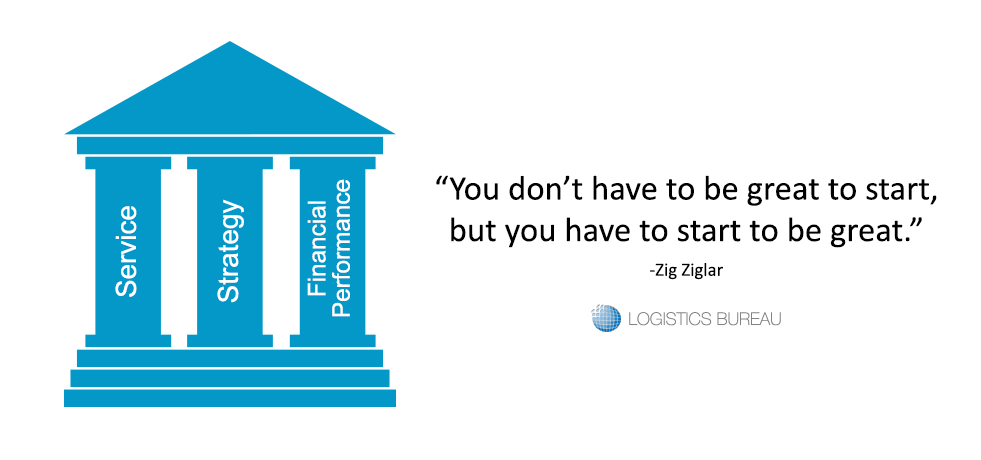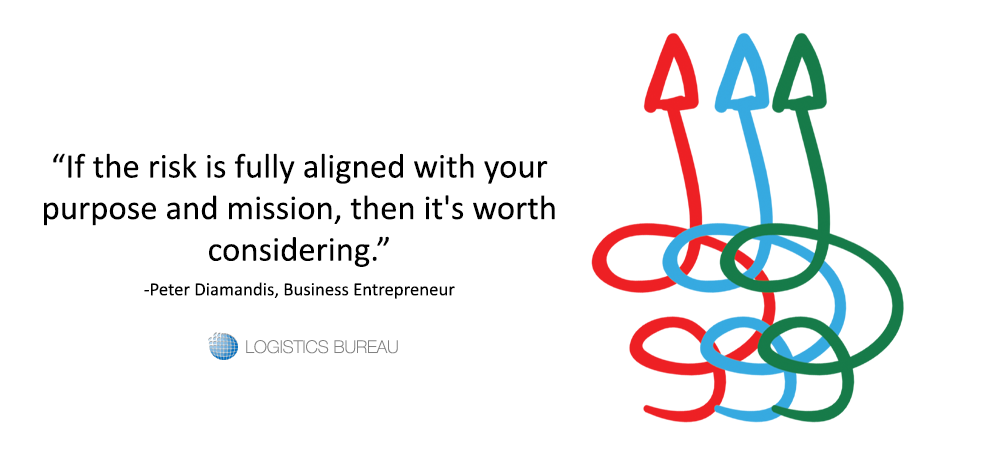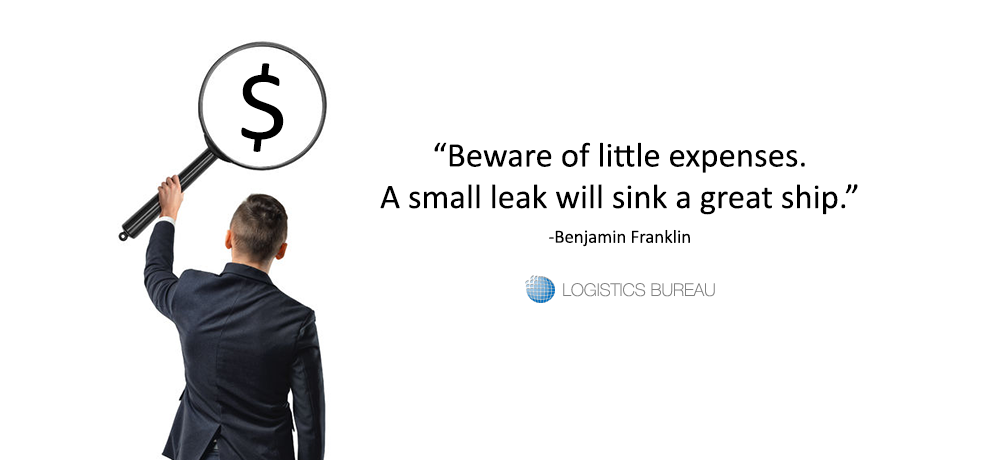Despite the apparent complexities involved in supply chain management, achieving excellence really doesn’t have to be too difficult. Just review and build on our three fundamental pillars of great supply chain management.
In this post, we explain what those pillars are, why they matter, and how to align them in a way that supports supply chain management excellence.

Our three pillars (or fundamentals) of great supply chain management excellence are strategy, service, and cost. Now as any architect will tell you, it’s a mistake to build on top of wonky pillars, so throughout this post, we’ll concentrate on aligning the three supply chain pillars … and the benefits of doing so.
The Importance of Alignment
Aligning strategy, service, and financial factors in your supply chain operation is essential to support your company’s overall business strategy, mission, and objectives. If you want to win the approval (and perhaps even admiration) of the C-suite, this alignment must be your primary supply chain management objective.

Why does the C-suite want the three pillars aligned? It’s because that’s what drives confidence and satisfaction among all your business stakeholders.
For example:
- Alignment of strategy and cost leads to happy shareholders
- Alignment of cost and service is good news for your customers
- Alignment of service and strategy provides focus for your managers and workforce
When shareholders, customers, and internal stakeholders all understand what your supply chain is about and how it supports them, your executive team has every reason to be happy with the way you are managing things.
If you’d like some practical help to get these supply chain pillars aligned in your company, the senior team at Logistics Bureau are all specialists in supply chain strategy. They will be pleased to guide, support, and assist you and your fellow supply chain leaders to develop or improve your supply chain strategy, and align it with the cost and service pillars.
But if, for now, you’re just interested in researching the issues and their impacts, let’s move on to look at how you can ensure the three pillars of supply chain excellence are aligned, taking each one in turn.
Aligning The 3 Pillars: What Does it Take?
Pillar 1: Supply Chain Service Alignment
We’ll begin by looking at service, because that’s where the people most important to your business will look. Your customers’ primary desire is to receive the right service levels at the right cost. We’ll look a little more at the cost element later, but first, let’s consider what it takes to align the service pillar of supply chain management.

It’s not that complicated, but there are three component areas that require a laser focus; inventory, policies, and planning. Let’s drill down and look at each of these service elements in more detail.
Inventory
Let’s be clear about one thing; your company’s customers don’t care one little bit about your internal costs associated with inventory. What they do care about is the unit price they pay for finished goods, and the availability of those goods.
From an inventory perspective then, service means maintaining an appropriate level of stock to meet your promises to your customers. On the other hand, carrying too much inventory will impact your operating costs in a number of ways, which can then also affect the prices your customers pay.
Remember what we said at the beginning of this post. Customer satisfaction depends on financial, as well as service alignment.
Hence it’s critical to balance inventory levels and deployment strategy to meet availability and cost requirements. Striking such a balance requires attention to the two other elements of service mentioned previously—policies and planning.
Policies
While the topic of policies can seem a bit stuffy and bureaucratic, it’s an element of supply chain management which should never be overlooked. Effective policies are vital for inventory management in particular.
Policies ensure consistency, and consistency reduces uncertainty—the nemesis of every supply chain.
Inventory policies offer your customers some assurance of availability. Policies relating to other elements of service delivery, such as perfect order fulfilment (on-time, in-full) provide clarity on the levels of service customers should expect as standard (and perhaps the options available for a premium).
As an example, let’s say that as a part of its customer service promise, your company guarantees its customers that they will receive their orders within 24 hours. In this case your supply chain service policy will need to support that promise, perhaps by specifying automatic use of expedited last-mile transportation as a response to upstream supply delays.
Of course, the aim should always be to serve customers proactively, and that’s where the third element of service alignment—planning—comes to the fore.
In the example above, effective planning will ensure that the use of expedited delivery (and the associated cost) is minimised. From this example, it’s not difficult to see how planning is vital to align both the service and financial pillars of supply chain management excellence.
Planning
Planning and policies are closely related to one another in the drive for supply chain management excellence. It’s important to plan carefully for example, in the development of policies to ensure they align with the needs of your business and its customers.
Similarly, you need to have robust policies in place for operational planning in your supply chain.
The following questions should help you to think about the effectiveness of planning within your supply chain operation:
- Do you have a sales and operations planning program in place?
- How accurate and effective is your demand planning?
- Is your supply planning optimised to get the best performance from manufacturing (if applicable), purchasing, warehouse, and transportation functions?
To return to the example in the previous section of this post, effective S&OP, demand, and supply planning performance will reduce the frequency with which you need to execute your expedited transportation policy.
At the same time, the policy will cover your operation for those (hopefully rare) occasions when plans are thwarted by circumstances outside of your control. Again then, you can hopefully see the close relationship between policy and planning in terms of service alignment.
Pillar 2: Supply Chain Financial Alignment
To align the financial pillar of supply chain excellence, you and your team should focus on costs and financial performance in four key areas, namely:
- Distribution network costs
- Warehouse operational costs
- Costs associated with transportation
- Procurement costs
These are the cost factors to get right if your supply chain is to support your business effectively, which makes each of them worth a little more exploration.

Distribution Network Costs
Achieving a cost-efficient distribution network is all about having the right number of warehouses and/or distribution centres in the right locations. It’s also about the trade-off between warehouse and transportation costs. We’re going to look at transportation shortly, so for now let’s concentrate on the “distribution nodes.”
Distribution nodes are the warehouses, distribution centres, and perhaps cross-dock or flow-through facilities that make up the static part of your network.
For your supply chain to support your business, these nodes must be located in such a way as to:
- Minimise warehouse and inventory costs, as well as the cost of outbound shipment
- Avoid the need for excessive internal transportation
- Ensure that you can deliver on your company’s customer service promise
Too many nodes will result in excessive warehouse cost and inventory levels. Too few and your transportation cost and service performance will suffer.
Facilities which are located in the wrong places can impact all of the costs previously mentioned and will likely affect service too.
Optimisation then, is the key. It’s not necessarily about having the lowest-cost in your distribution network; it’s about finding the least expensive way to deliver fully and reliably on your company’s customer promise.
Warehouse Costs
Even if you have just the right number of distribution nodes in your network, in just the right locations, financial alignment can be improved further with some keen attention to what goes on inside your distribution centres and warehouses.
Each warehouse in your network should have a layout optimised for cost-efficiency. Warehouse processes too should be examined and continuously tweaked to optimise performance.
In fact, the warehouse is one supply chain area in which a truly lean approach can be taken to cost reduction.
Quite simply, the more you can remove waste such as travel, motion, waiting, over-processing, and inventory damage/loss from your warehouses, the higher will be your throughput and the lower your costs.
Transportation Costs
The cost of transportation within your supply chain is closely linked to the number and placement of your facilities. If you optimise your company’s supply chain network effectively, you’ll enjoy lower transportation costs.
Of course optimising an existing network can be a very costly process in itself, and it’s not always possible to get it done in one fell swoop.
In this case there are other measures you can take to improve your transportation cost profile. Much depends on whether you operate an in-house fleet or outsource transportation to third-party specialists.
Many companies have successfully reduced transportation costs and improved service by switching from internal to outsourced distribution models, although it must be said that this is not a guaranteed solution. The decision to outsource logistics is one which must follow extensive evaluation.
If you already use third-party logistics, it’s worth querying the current cost-effectiveness of your strategy—perhaps by asking questions such as:
- Can the transportation rate structure be improved?
- Are partnerships being managed effectively?
- Are the most efficient modes of transportation being utilised?
- Could your customer base be split into segments tied to tiered levels of delivery service?
Whether transportation is outsourced or retained in-house, a continuous improvement approach will almost always unearth cost-reduction opportunities, as well as possibilities to incrementally improve profits and enhance customer service.
The secret is to never stop asking why you do things the way you do, and if they are still the best ways for your business.
Procurement Costs
Procurement plays a huge role in supply chain financial alignment. That doesn’t mean your company should seek the lowest unit price possible for every product or material that it purchases.
Achieving the lowest prices will rarely be the most appropriate strategy to support a business effectively.
Instead, the primary procurement imperative should be to extract value from every supplier relationship. In order to do this, inbound supplies should be categorised according to strategic importance, and supplier relationships should be managed accordingly.
At the same time, try looking for ways to align the cost of the procurement process itself. Take advantage of procurement technology where possible to streamline processes and reduce the cost involved with each supplier/buyer transaction.
Effective supplier relationship management will help here too, by encouraging collaborative efforts to reduce transaction costs for your company and its most strategically important suppliers.
Pillar 3: Supply Chain Strategy Alignment
So far we’ve looked at a number of functional areas in the supply chain and the importance of making sure they are aligned with the goals of your business. None of it is rocket science and you can be forgiven for thinking that most companies are committed to high performance in these areas. In fact, they probably are.
What tends to separate best-in-class supply chain organisations from the rest though, is the alignment of the third pillar—supply chain strategy.

Strategic misalignment renders supply chain service and cost performance a product of luck as much as judgement, regardless of the rigor with which improvement is pursued. To be successful, your supply chain strategy must be clear to all, continuously developed and calibrated regularly to maintain relevance.
When we’re asked to provide our supply chain strategy services, the client, more often than not, will tell us that aligning the supply chain strategy with that of the overall business is a primary objective.
Upon review, it’s common for our consultants to identify several areas of misalignment, but one of the other issues they often see is that the strategy is steeped in too much detail to be understandable, or is just not clearly defined at all.
Clarity of the Supply Chain Strategy
While strategy development and calibration are topics for senior leadership to consider, the key elements of supply chain strategy should be no secret to lower management echelons and the general workforce.
In aligning the 3 pillars of supply chain excellence, successful companies ensure strategic clarity exists all the way through the enterprise. They recognise that to be effective, the supply chain strategy must be articulated in a language understood by all.
They communicate strategy in a way that makes it easy for warehouse operatives, drivers, administrative staff, purchasing people, factory technicians, and other functional staff to get behind the strategy and fulfil their roles in its execution.
So if you want to align your supply chain strategy, you need first to ask if everyone in your organisation understands the strategic goals and imperatives. Do they all know how their individual efforts support the strategy? If not, you will need to implement a communication plan to improve clarity across all functions, and at all levels.
Development of Supply Chain Strategy
Continuous improvement has been mentioned a number of times in this post, and it applies as much to your supply chain strategy as to anything else. Supply chain strategy is not something you can just set and forget.
Your strategy should be reviewed on a regular basis, and adjusted as and when required to ensure it continues to serve the interests of your customers, shareholders, and internal stakeholders.
Remember that over time, your company’s business strategy may change, and external forces may also steer your supply chain plan in a new direction. Nothing stays the same for long, and your supply chain strategy must always be in a state of development to keep up with the changes.
Calibration of Supply Chain Strategy
The final vital component for an aligned supply chain strategy is calibration. Just as you can’t set and forget your strategy, the KPIs and other metrics which serve as your compass must also be regularly checked for accuracy and validity.
Without appropriate attention, metrics can lose validity over time and if this happens, your leadership team will lack performance awareness. So keep an eye on those KPIs to make sure they are still tracking what matters most.
For example, if your strategic focus has shifted over time from cost-reduction to a more service-oriented model, but your KPI suite is still weighted toward financial measures, it will be hard to see how well your strategy is currently serving the business, and even harder to implement solutions prioritising quality.
Align Your Way to Supply Chain Excellence
Service, strategy, and financial alignment, that’s all it comes down to. Supply chain management can sometimes seem a complicated affair, but really, it’s just a matter of focusing on the needs of customers, internal stakeholders, and shareholders. Those needs are satisfied when the three supply chain pillars are fully aligned.
At Logistics Bureau, our consulting team has helped hundreds of companies graduate from good to great supply chain management, simply by working on alignment across the three areas covered in our alignment model outlined this post.
We offer a comprehensive supply chain strategy service, which includes assistance with strategy development and alignment. As part of that service, we can help you to ensure the three pillars of supply chain management are aligned and effectively supporting your overall strategy.
The main features of the service include:
- A structured series of workshops involving a senior cross-functional team from your business
- Development of a fully documented supply chain strategy, with objectives, action plans, responsibilities and timelines.
- Assistance with communicating the strategy to all business stakeholders and staff
To find out more about this service and see some case studies, please visit the Logistics Bureau supply chain strategy service page, and if you already recognise some alignment issues in your supply chain operation, and you need a little help to iron them out, we’re ready and waiting to hear from you.
Editor’s Note: The content of this post was originally published on Logistics Bureau’s website dated May 31, 2022, under the title “The 3 Pillars of Supply Chain Management (And Why Their Alignment Matters)“.


